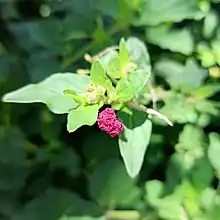| Boerhavia coccinea | |
|---|---|
 | |
| Scientific classification | |
| Kingdom: | Plantae |
| Clade: | Tracheophytes |
| Clade: | Angiosperms |
| Clade: | Eudicots |
| Order: | Caryophyllales |
| Family: | Nyctaginaceae |
| Genus: | Boerhavia |
| Species: | B. coccinea |
| Binomial name | |
| Boerhavia coccinea | |
| Synonyms | |
|
Boerhavia caribaea | |
Boerhavia coccinea is a species of flowering plant in the four o'clock family which is known by many common names, including scarlet spiderling, red boerhavia, and in Spanish, hierba del cancer and hierba de la hormiga. The plant exists in many parts of the world and is an invasive species in most.[1] Despite its expanded distribution and weed-like characteristics, the plant has historically been used for its medicinal properties.[2][3]
Invasiveness
Outside of B. coccinea's native habitat of tropical America, the plant is considered an invasive weed in many parts of the world. Perhaps the most well-known instance of the plant's naturalization is the southeastern United States. A few distant locations of invasion include Hawaii, Africa, Australia, and even a few Asian countries.[1] In Asia, specifically in Taiwan, B. coccinea is found among other weeds on the sides of roads, in lawns, and along bodies of water. Globally, the plant tends to live near large bodies of water.[1] In Africa, B. coccinea has been found in Uganda, Kenya, and Tanzania.[4] Even in places where the plant is native, such as Sonora, Mexico, the weed is often found competing with important crops.[5]
Description
This plant grows in a wide variety of habitats, including disturbed areas as a common roadside weed. It is a low-lying, sprawling perennial herb producing reaching stems which can exceed a meter in length. The stems are somewhat hairy and sticky with glands. The generally oval-shaped leaves are held on short petioles. They are wavy along the edges and may have reddish margins. The inflorescence is a small head of tiny frilly flowers, each just a few millimeters long. The flowers are often bright scarlet to red-violet in color but can be shades of pink, yellow, or white.[6]

Uses
The leaves and roots of B. coccinea are used medicinally in countries including Cameroon, Ethiopia, Namibia, Nigeria, Tanzania, Mexico, Brazil, Argentina, and Paraguay.[7] In traditional Mexican Medicine, B. coccinea has been used to treat conditions such as diarrhea and dysentery.[2] The plant is usually used medicinally to treat pain and inflammation because of its anti-inflammatory and antinociceptive properties. The chemical explanation for these properties is an active topic of research.[3] It is also eaten by humans and used as animal feed. A flour can be made from its seeds.
References
- 1 2 3 Chen, Shih-Huei; Wu, Ming-Jou (December 2007). "A Taxonomical Study of the Genus Boerhavia (Nyctaginaceae) in Taiwan". Tawania. 52 (4): 332–342 – via Tawania.
- 1 2 Osuna, L.; Tapia-Pérez, M.E.; Jiménez-Ferrer, J.E.; Carrillo-Quiróz, B.A.; Silva-Sánchez, J. (January 2005). "Screening of Alternanthera repens ., Boerhavia coccinea ., Flaveria trinervia ., Tournefortia densiflora ., and Vitex mollis . Extracts to Evaluate their Antibacterial Activity and Effect on Smooth Muscle. I". Pharmaceutical Biology. 43 (9): 749–753. doi:10.1080/13880200500406412. ISSN 1388-0209.
- 1 2 Piegang, Basile Nganmegne; Ndjateu, Fabrice Sterlin Tchantchou; Tene, Mathieu; Bomba, Francis Désiré Tatsinkou; Tseuguem, Pius Pum; Nguelefack, Télesphore Benoit (2021-01-01). "Antinociceptive, anti-inflammatory and antioxidant effects of Boerhavia coccinea extracts and fractions on acute and persistent inflammatory pain models". Journal of Basic and Clinical Physiology and Pharmacology. 32 (1). doi:10.1515/jbcpp-2020-0118. ISSN 2191-0286.
- ↑ Whitehouse, CHRISTOPHER (1996). "BOERHAVIA coccinea Mill. [family NYCTAGINACEAE] on JSTOR". plants.jstor.org. Retrieved 2023-11-20.
- ↑ DE LEÓN DE LA LUZ, JOSÉ LUIS; REBMAN, JON; DOMÍNGUEZ LEÓN, MIGUEL; DOMÍNGUEZ CADENA, RAYMUNDO (2008-06-01). "La flora vascular y las relaciones florísticas de la sierra de La Giganta de Baja California Sur, México". Revista Mexicana de Biodiversidad. 79 (001). doi:10.22201/ib.20078706e.2008.001.532. ISSN 2007-8706.
- ↑ Flora of North America
- ↑ van de Witte, Ymkje, ed. (16 November 2021) [23 February 2016]. "Boerhavia coccinea (scarlet spiderling)". www.cabi.org. Retrieved 2022-08-11.
External links